SNOSAY9G September 2008 – February 2016 LMP2021 , LMP2022
PRODUCTION DATA.
- 1 Features
- 2 Applications
- 3 Description
- 4 Revision History
- 5 Pin Configuration and Functions SC-70 and VSSOP references from LMP2021 pinout descriptions
- 6 Specifications
- 7 Detailed Description
- 8 Application and Implementation
- 9 Power Supply Recommendations
- 10Layout
- 11Device and Documentation Support
- 12Mechanical, Packaging, and Orderable Information
Package Options
Mechanical Data (Package|Pins)
Thermal pad, mechanical data (Package|Pins)
Orderable Information
6 Specifications
6.1 Absolute Maximum Ratings(1)(2)
| MIN | MAX | UNIT | ||
|---|---|---|---|---|
| VIN Differential | –VS | VS | ||
| Supply Voltage (VS = V+ – V−) | 6.0 | V | ||
| All Other Pins | V+ + 0.3 | V− − 0.3 | V | |
| Output Short-Circuit Duration to V+ or V−(3) | 5 | seconds | ||
| Junction Temperature(4) | 150 | °C | ||
| Soldering Information | Infrared or Convection (20 sec) | 235 | °C | |
| Wave Soldering Lead Temperature (10 sec) | 260 | °C | ||
| Tstg | Storage temperature range | −65 | 150 | °C |
(1) Absolute Maximum Ratings indicate limits beyond which damage to the device may occur. Recommended Operating Conditions indicate conditions for which the device is intended to be functional, but specific performance is not ensured. For ensured specifications and the test conditions, see the Electrical Characteristics Tables.
(2) If Military/Aerospace specified devices are required, please contact the TI Sales Office/ Distributors for availability and specifications.
(3) Package power dissipation should be observed.
(4) The maximum power dissipation is a function of TJ(MAX), θJA, and TA. The maximum allowable power dissipation at any ambient temperature is PD = (TJ(MAX) - TA)/ θJA. All numbers apply for packages soldered directly onto a PC board.
6.2 ESD Ratings
| VALUE | UNIT | |||
|---|---|---|---|---|
| V(ESD) | Electrostatic discharge | Human body model (HBM), per ANSI/ESDA/JEDEC JS-001, all pins(1) | ±2000 | V |
| Charged device model (CDM), per JEDEC specification JESD22-C101, all pins(2) | ±1000 | |||
| Machine model | ±200 | |||
(1) JEDEC document JEP155 states that 500-V HBM allows safe manufacturing with a standard ESD control process.
(2) JEDEC document JEP157 states that 250-V CDM allows safe manufacturing with a standard ESD control process.
6.3 Recommended Operating Conditions
over operating free-air temperature range (unless otherwise noted)| MIN | MAX | UNIT | ||
|---|---|---|---|---|
| Temperature Range | −40 | 125 | °C | |
| Supply Voltage (VS = V+ – V–) | 2.2 | 5.5 | V | |
6.4 Thermal Information
| THERMAL METRIC(1) | LMP2021, LMP2022 | LMP2021 | LMP2022 | UNIT | |
|---|---|---|---|---|---|
| D | DBV | DGK | |||
| 8 PINS | 5 PINS | 8 PINS | |||
| RθJA | Junction-to-ambient thermal resistance | 106 | 164 | 217 | °C/W |
(1) For more information about traditional and new thermal metrics, see the IC Package Thermal Metrics application report, SPRA953.
6.5 Electrical Characteristics: 2.5 V(1)
Unless otherwise specified, all limits are ensured for TA = 25°C, V+ = 2.5 V, V− = 0 V, VCM = V+/2, RL >10 kΩ to V+/2.| PARAMETER | TEST CONDITIONS | MIN(3) | TYP(2) | MAX(3) | UNIT | ||
|---|---|---|---|---|---|---|---|
| VOS | Input Offset Voltage | –5 | –0.9 | 5 | μV | ||
| –40°C ≤ TJ ≤ 125°C | –10 | 10 | |||||
| TCVOS | Input Offset Voltage Drift(4) | –0.02 | 0.001 | 0.02 | μV/°C | ||
| IB | Input Bias Current | –100 | ±23 | 100 | pA | ||
| –40°C ≤ TJ ≤ 125°C | –300 | 300 | |||||
| IOS | Input Offset Current | –200 | ±57 | 200 | pA | ||
| –40°C ≤ TJ ≤ 125°C | –250 | 250 | |||||
| CMRR | Common Mode Rejection Ratio | −0.2 V ≤ VCM ≤ 1.7 V, 0 V ≤ VCM ≤ 1.5 V | 105 | 141 | dB | ||
| −0.2 V ≤ VCM ≤ 1.7 V, 0 V ≤ VCM ≤ 1.5 V, –40°C ≤ TJ ≤ 125°C | 102 | ||||||
| CMVR | Input Common-Mode Voltage Range | Large Signal CMRR ≥ 105 dB | −0.2 | 1.7 | V | ||
| Large Signal CMRR ≥ 102 dB, –40°C ≤ TJ ≤ 125°C | 0 | 1.5 | |||||
| EMIRR | Electro-Magnetic Interference Rejection Ratio(3) | IN+ and IN− | VRF-PEAK = 100 mVP (−20 dBVP) f = 400 MHz |
40 | dB | ||
| VRF-PEAK = 100 mVP (−20 dBVP) f = 900 MHz |
48 | ||||||
| VRF-PEAK = 100 mVP (−20 dBVP) f = 1800 MHz |
67 | ||||||
| VRF-PEAK = 100 mVP (−20 dBVP) f = 2400 MHz |
79 | ||||||
| PSRR | Power Supply Rejection Ratio | 2.5 V ≤ V+ ≤ 5.5 V, VCM = 0 | 115 | 130 | dB | ||
| 2.5 V ≤ V+ ≤ 5.5 V, VCM = 0 , –40°C ≤ TJ ≤ 125°C | 112 | ||||||
| 2.2 V ≤ V+ ≤ 5.5 V, VCM = 0 | 110 | 130 | |||||
| AVOL | Large Signal Voltage Gain | RL = 10 kΩ to V+/2, VOUT = 0.5 V to 2 V | 124 | 150 | dB | ||
| RL = 10 kΩ to V+/2, VOUT = 0.5 V to 2 V, –40°C ≤ TJ ≤ 125°C | 119 | ||||||
| RL = 2 kΩ to V+/2, VOUT = 0.5 V to 2 V | 120 | 150 | |||||
| RL = 2 kΩ to V+/2, VOUT = 0.5 V to 2 V, –40°C ≤ TJ ≤ 125°C | 115 | ||||||
| VOUT | Output Swing High | RL = 10 kΩ to V+/2 | 38 | 50 | mV from either rail |
||
| RL = 10 kΩ to V+/2, –40°C ≤ TJ ≤ 125°C | 70 | ||||||
| RL = 2 kΩ to V+/2 | 62 | 85 | |||||
| RL = 2 kΩ to V+/2, –40°C ≤ TJ ≤ 125°C | 115 | ||||||
| Output Swing Low | RL = 10 kΩ to V+/2 | 30 | 45 | ||||
| RL = 10 kΩ to V+/2, –40°C ≤ TJ ≤ 125°C | 55 | ||||||
| RL = 2 kΩ to V+/2 | 58 | 75 | |||||
| RL = 2 kΩ to V+/2, –40°C ≤ TJ ≤ 125°C | 95 | ||||||
| IOUT | Linear Output Current |
Sourcing, VOUT = 2 V | 30 | 50 | mA | ||
| Sinking, VOUT = 0.5 V | 30 | 50 | |||||
| IS | Supply Current | Per Amplifier | 0.95 | 1.10 | mA | ||
| Per Amplifier, –40°C ≤ TJ ≤ 125°C | 1.37 | ||||||
| SR | Slew Rate(5) | AV = +1, CL = 20 pF, RL = 10 kΩ VO = 2 VPP |
2.5 | V/μs | |||
| GBW | Gain Bandwidth Product | CL = 20 pF, RL = 10 kΩ | 5 | MHz | |||
| GM | Gain Margin | CL = 20 pF, RL = 10 kΩ | 10 | dB | |||
| ΦM | Phase Margin | CL = 20 pF, RL = 10 kΩ | 60 | deg | |||
| CIN | Input Capacitance | Common Mode | 12 | pF | |||
| Differential Mode | 12 | ||||||
| en | Input-Referred Voltage Noise Density | f = 0.1 kHz or 10 kHz, AV = 1000 | 11 | nV/√Hz | |||
| f = 0.1 kHz or 10 kHz, AV = 100 | 15 | ||||||
| Input-Referred Voltage Noise | 0.1 Hz to 10 Hz | 260 | nVPP | ||||
| 0.01 Hz to 10 Hz | 330 | ||||||
| In | Input-Referred Current Noise | f = 1 kHz | 350 | fA/√Hz | |||
| tr | Recovery time | to 0.1%, RL = 10 kΩ, AV = −50, VOUT = 1.25 VPP Step, Duration = 50 μs |
50 | µs | |||
| CT | Cross Talk | LMP2022, f = 1 kHz | 150 | dB | |||
(1) Electrical Table values apply only for factory testing conditions at the temperature indicated. Factory testing conditions result in very limited self-heating of the device such that TJ = TA. No specification of parametric performance is indicated in the electrical tables under conditions of internal self-heating where TJ > TA.
(2) Typical values represent the most likely parametric norm at the time of characterization. Actual typical values may vary over time and will also depend on the application and configuration. The typical values are not tested and are not ensured on shipped production material.
(3) All limits are specified by testing, statistical analysis or design.
(4) Offset voltage temperature drift is determined by dividing the change in VOS at the temperature extremes by the total temperature change.
(5) The number specified is the average of rising and falling slew rates and is measured at 90% to 10%.
6.6 Electrical Characteristics: 5 V(1)
Unless otherwise specified, all limits are ensured for TA = 25°C, V+ = 5 V, V− = 0 V, VCM = V+/2, RL > 10 kΩ to V+/2.| PARAMETER | TEST CONDITIONS | MIN(3) | TYP(2) | MAX(3) | UNIT | ||
|---|---|---|---|---|---|---|---|
| VOS | Input Offset Voltage | –5 | −0.4 | 5 | μV | ||
| –40°C ≤ TJ ≤ 125°C | –10 | 10 | |||||
| TCVOS | Input Offset Voltage Drift(2) | –0.02 | −0.004 | 0.02 | μV/°C | ||
| IB | Input Bias Current | –100 | ±25 | 100 | pA | ||
| –40°C ≤ TJ ≤ 125°C | –300 | 300 | |||||
| IOS | Input Offset Current | –200 | ±48 | 200 | pA | ||
| –40°C ≤ TJ ≤ 125°C | –250 | 250 | |||||
| CMRR | Common Mode Rejection Ratio | −0.2 V ≤ VCM ≤ 4.2 V, 0 V ≤ VCM ≤ 4.0 V | 120 | 139 | dB | ||
| −0.2 V ≤ VCM ≤ 4.2 V, 0 V ≤ VCM ≤ 4.0 V, –40°C ≤ TJ ≤ 125°C | 115 | ||||||
| CMVR | Input Common-Mode Voltage Range | Large Signal CMRR ≥ 120 dB | –0.2 | 4.2 | V | ||
| Large Signal CMRR ≥ 115 dB, –40°C ≤ TJ ≤ 125°C | 0 | 4.0 | |||||
| EMIRR | Electro-Magnetic Interference Rejection Ratio(3) | IN+ and IN− | VRF-PEAK = 100 mVP (−20 dBVP) f = 400 MHz |
58 | dB | ||
| VRF-PEAK = 100 mVP (−20 dBVP) f = 900 MHz |
64 | ||||||
| VRF-PEAK = 100 mVP (−20 dBVP) f = 1800 MHz |
72 | ||||||
| VRF-PEAK = 100 mVP (−20 dBVP) f = 2400 MHz |
82 | ||||||
| PSRR | Power Supply Rejection Ratio | 2.5 V ≤ V+ ≤ 5.5 V, VCM = 0 | 115 | 130 | dB | ||
| 2.5 V ≤ V+ ≤ 5.5 V, VCM = 0, –40°C ≤ TJ ≤ 125°C | 112 | ||||||
| 2.2 V ≤ V+ ≤ 5.5 V, VCM = 0 | 110 | 130 | |||||
| AVOL | Large Signal Voltage Gain | RL = 10 kΩ to V+/2, VOUT = 0.5 V to 4.5 V | 125 | 160 | dB | ||
| RL = 10 kΩ to V+/2, VOUT = 0.5 V to 4.5 V, –40°C ≤ TJ ≤ 125°C | 120 | ||||||
| RL = 2 kΩ to V+/2, VOUT = 0.5 V to 4.5 V | 123 | 160 | |||||
| RL = 2 kΩ to V+/2, VOUT = 0.5 V to 4.5 V, –40°C ≤ TJ ≤ 125°C | 118 | ||||||
| VOUT | Output Swing High | RL = 10 kΩ to V+/2 | 83 | 135 | mV from either rail |
||
| RL = 10 kΩ to V+/2, –40°C ≤ TJ ≤ 125°C | 170 | ||||||
| RL = 2 kΩ to V+/2 | 120 | 160 | |||||
| RL = 2 kΩ to V+/2, –40°C ≤ TJ ≤ 125°C | 204 | ||||||
| Output Swing Low | RL = 10 kΩ to V+/2 | 65 | 80 | ||||
| RL = 10 kΩ to V+/2, –40°C ≤ TJ ≤ 125°C | 105 | ||||||
| RL = 2 kΩ to V+/2 | 103 | 125 | |||||
| RL = 2 kΩ to V+/2, –40°C ≤ TJ ≤ 125°C | 158 | ||||||
| IOUT | Linear Output Current |
Sourcing, VOUT = 4.5 V | 30 | 50 | mA | ||
| Sinking, VOUT = 0.5 V | 30 | 50 | |||||
| IS | Supply Current | Per Amplifier | 1.1 | 1.25 | mA | ||
| Per Amplifier, –40°C ≤ TJ ≤ 125°C | 1.57 | ||||||
| SR | Slew Rate(4) | AV = +1, CL = 20 pF, RL = 10 kΩ VO = 2 VPP |
2.6 | V/μs | |||
| GBW | Gain Bandwidth Product | CL = 20 pF, RL = 10 kΩ | 5 | MHz | |||
| GM | Gain Margin | CL = 20 pF, RL = 10 kΩ | 10 | dB | |||
| ΦM | Phase Margin | CL = 20 pF, RL = 10 kΩ | 60 | deg | |||
| CIN | Input Capacitance | Common Mode | 12 | pF | |||
| Differential Mode | 12 | ||||||
| en | Input-Referred Voltage Noise Density | f = 0.1 kHz or 10 kHz, AV= 1000 | 11 | nV/√Hz | |||
| f = 0.1 kHz or 10 kHz, AV= 100 | 15 | ||||||
| Input-Referred Voltage Noise | 0.1 Hz to 10 Hz Noise | 260 | nVPP | ||||
| 0.01 Hz to 10 Hz Noise | 330 | ||||||
| In | Input-Referred Current Noise | f = 1 kHz | 350 | fA/√Hz | |||
| tr | Input Overload Recovery time | to 0.1%, RL = 10 kΩ, AV = −50, VOUT = 2.5 VPP Step, Duration = 50 μs |
50 | μs | |||
| CT | Cross Talk | LMP2022, f = 1 kHz | 150 | dB | |||
(1) Electrical Table values apply only for factory testing conditions at the temperature indicated. Factory testing conditions result in very limited self-heating of the device such that TJ = TA. No specification of parametric performance is indicated in the electrical tables under conditions of internal self-heating where TJ > TA.
(2) Offset voltage temperature drift is determined by dividing the change in VOS at the temperature extremes by the total temperature change.
(3) The EMI Rejection Ratio is defined as EMIRR = 20Log ( VRF-PEAK/ΔVOS).
(4) The number specified is the average of rising and falling slew rates and is measured at 90% to 10%.
6.7 Typical Characteristics
Unless otherwise noted: TA = 25°C, RL > 10 kΩ, VS= V+ – V–, VS= 5 V, VCM = VS/2.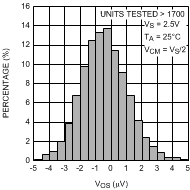 Figure 1. Offset Voltage Distribution
Figure 1. Offset Voltage Distribution
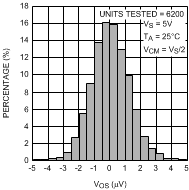 Figure 3. Offset Voltage Distribution
Figure 3. Offset Voltage Distribution
 Figure 5. Offset Voltage vs. Supply Voltage
Figure 5. Offset Voltage vs. Supply Voltage
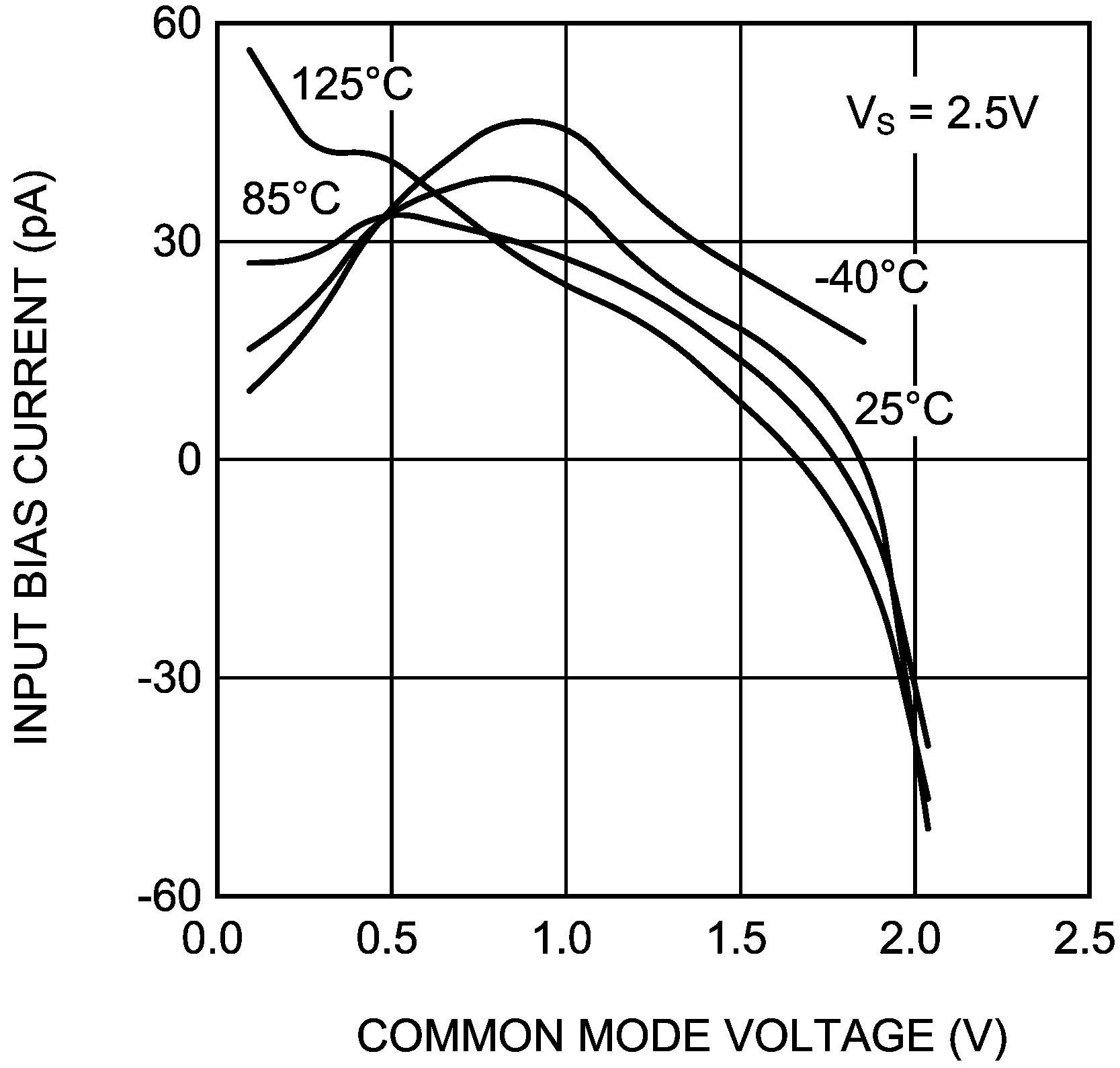 Figure 7. Input Bias Current vs. VCM
Figure 7. Input Bias Current vs. VCM
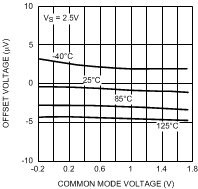 Figure 9. Offset Voltage vs. VCM
Figure 9. Offset Voltage vs. VCM
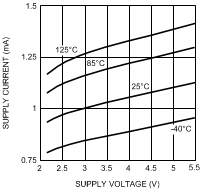 Figure 11. Supply Current vs. Supply Voltage (Per Amplifier)
Figure 11. Supply Current vs. Supply Voltage (Per Amplifier)
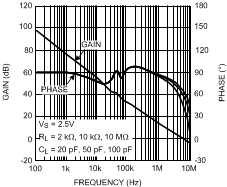 Figure 13. Open Loop Frequency Response
Figure 13. Open Loop Frequency Response
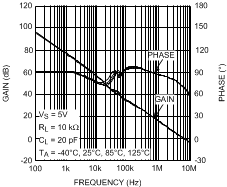 Figure 15. Open Loop Frequency Response Over Temperature
Figure 15. Open Loop Frequency Response Over Temperature
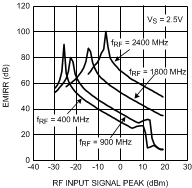 Figure 17. EMIRR vs. Input Power
Figure 17. EMIRR vs. Input Power
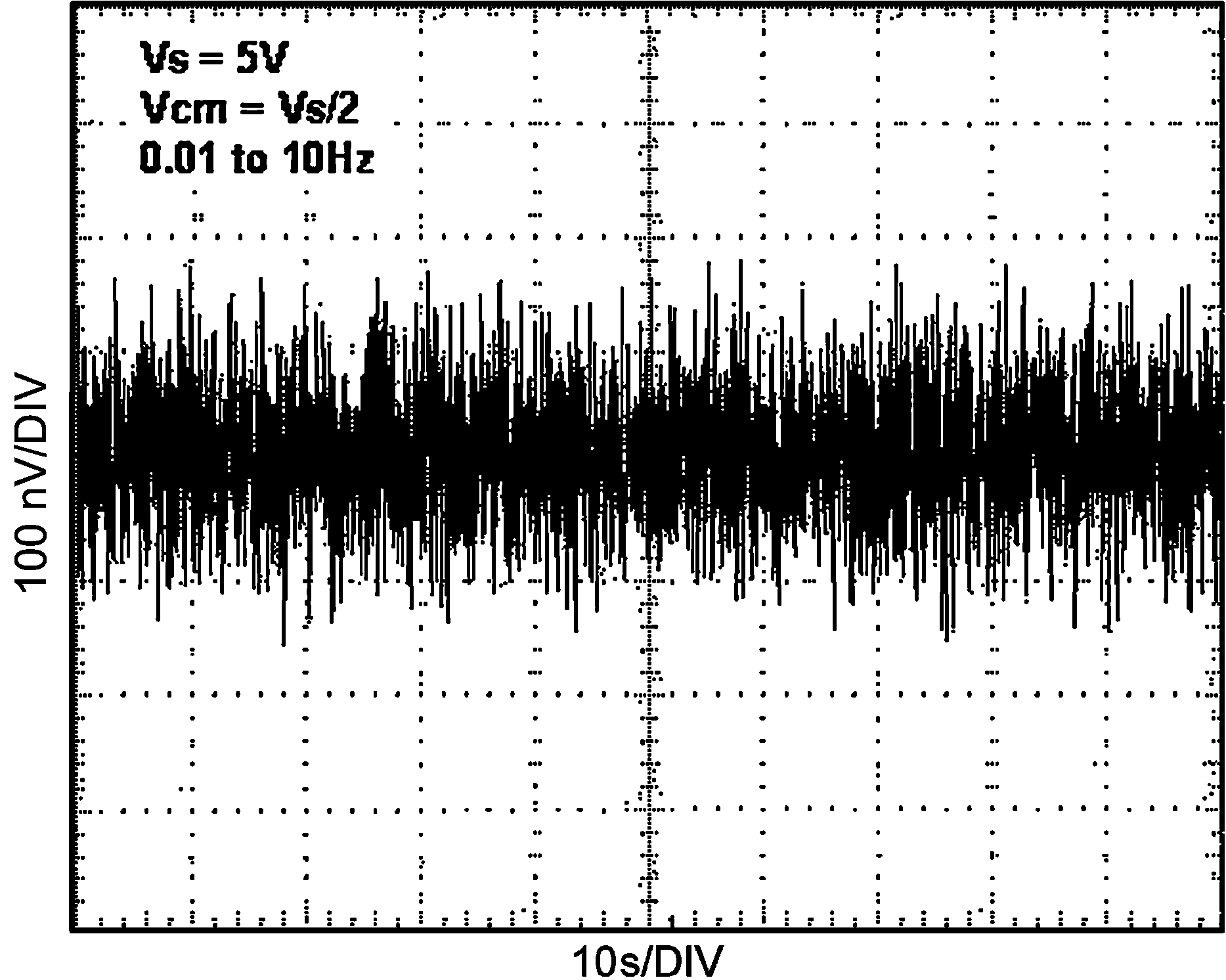 Figure 19. Time Domain Input Voltage Noise
Figure 19. Time Domain Input Voltage Noise
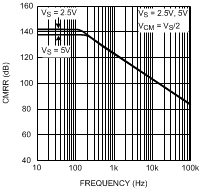 Figure 21. CMRR vs. Frequency
Figure 21. CMRR vs. Frequency
 Figure 23. Output Swing High vs. Supply Voltage
Figure 23. Output Swing High vs. Supply Voltage
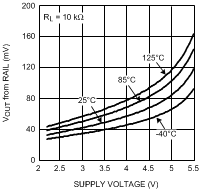 Figure 25. Output Swing High vs. Supply Voltage
Figure 25. Output Swing High vs. Supply Voltage
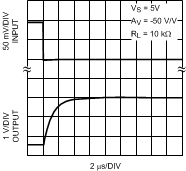 Figure 27. Overload Recovery Time
Figure 27. Overload Recovery Time
 Figure 29. Large Signal Step Response
Figure 29. Large Signal Step Response
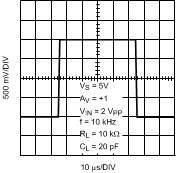 Figure 31. Large Signal Step Response
Figure 31. Large Signal Step Response
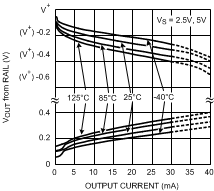 Figure 33. Output Voltage vs. Output Current
Figure 33. Output Voltage vs. Output Current
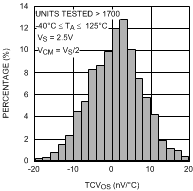 Figure 2. TCVOS Distribution
Figure 2. TCVOS Distribution
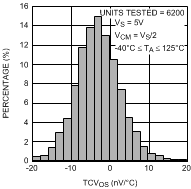 Figure 4. TCVOS Distribution
Figure 4. TCVOS Distribution
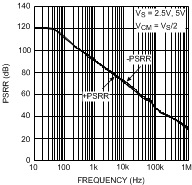 Figure 6. PSRR vs. Frequency
Figure 6. PSRR vs. Frequency
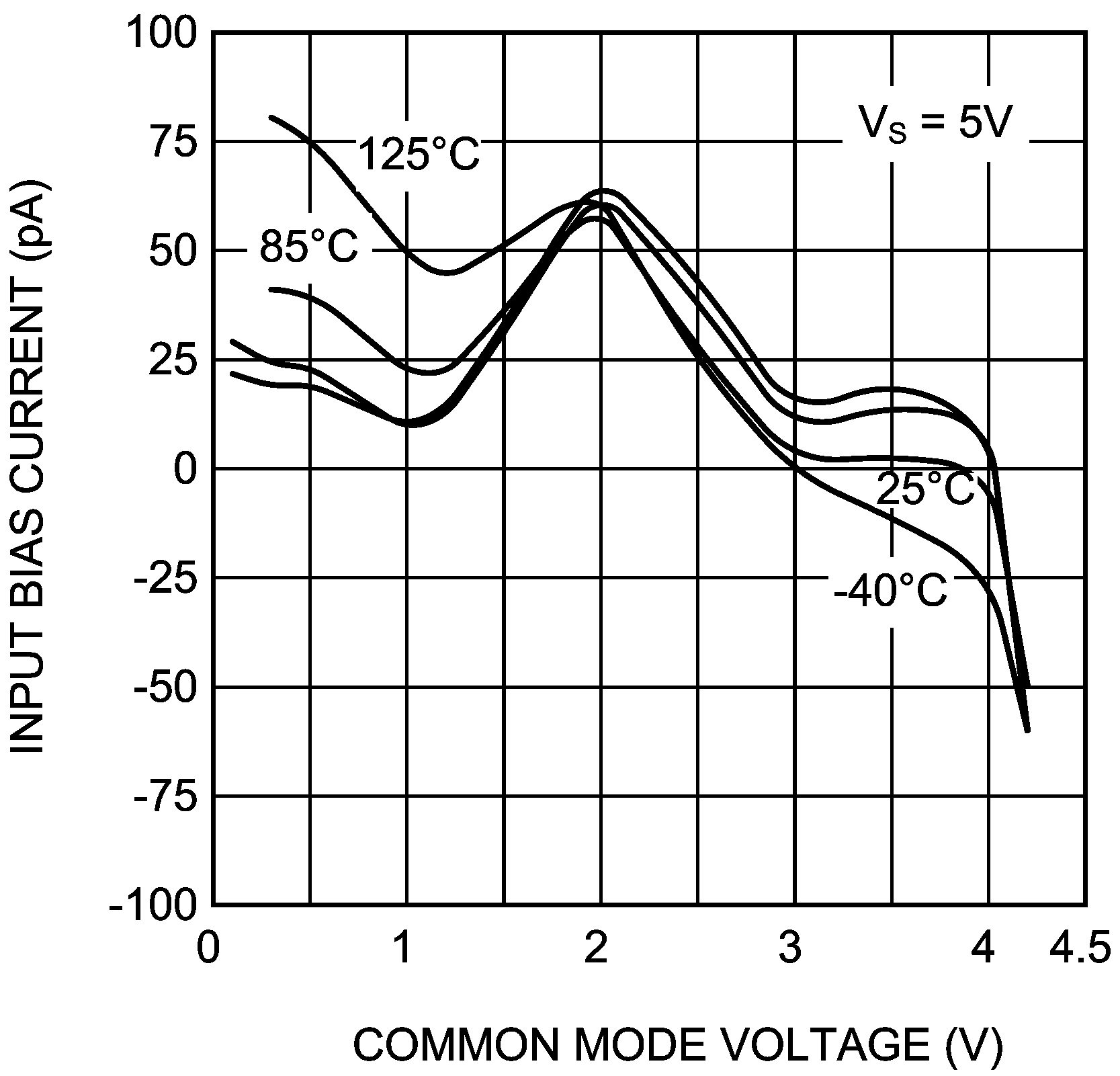 Figure 8. Input Bias Current vs. VCM
Figure 8. Input Bias Current vs. VCM
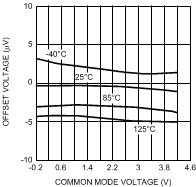 Figure 10. Offset Voltage vs. VCM
Figure 10. Offset Voltage vs. VCM
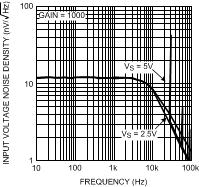 Figure 12. Input Voltage Noise vs. Frequency
Figure 12. Input Voltage Noise vs. Frequency
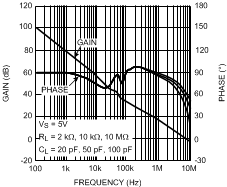 Figure 14. Open Loop Frequency Response
Figure 14. Open Loop Frequency Response
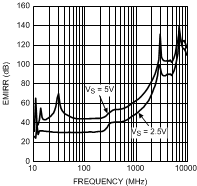 Figure 16. EMIRR vs. Frequency
Figure 16. EMIRR vs. Frequency
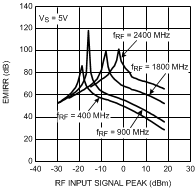 Figure 18. EMIRR vs. Input Power
Figure 18. EMIRR vs. Input Power
 Figure 20. Time Domain Input Voltage Noise
Figure 20. Time Domain Input Voltage Noise
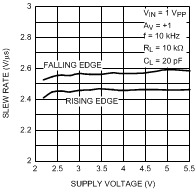 Figure 22. Slew Rate vs. Supply Voltage
Figure 22. Slew Rate vs. Supply Voltage
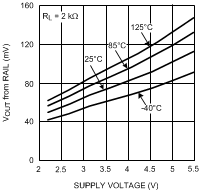 Figure 24. Output Swing Low vs. Supply Voltage
Figure 24. Output Swing Low vs. Supply Voltage
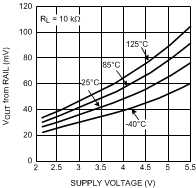 Figure 26. Output Swing Low vs. Supply Voltage
Figure 26. Output Swing Low vs. Supply Voltage
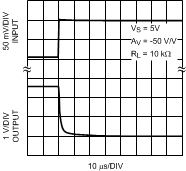 Figure 28. Overload Recovery Time
Figure 28. Overload Recovery Time
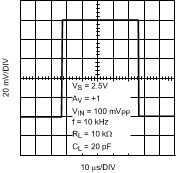 Figure 30. Small Signal Step Response
Figure 30. Small Signal Step Response
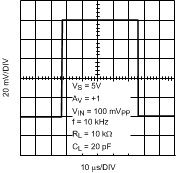 Figure 32. Small Signal Step Response
Figure 32. Small Signal Step Response
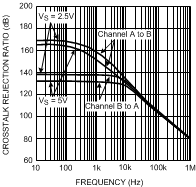 Figure 34. Cross Talk Rejection Ratio vs. Frequency (LMP2022)
Figure 34. Cross Talk Rejection Ratio vs. Frequency (LMP2022)